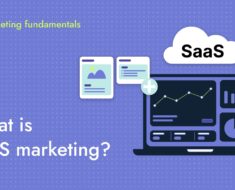
In a data-driven environment, your marketing and sales personnel can exceed their expectations with the data available on the B2B list using Account-based Marketing (ABM) and Multichannel Marketing (MCM) strategies.
These approaches can help in pinpointing the right person to contact, appropriate offerings to provide, the right message about your brand they need to deliver, and the right mechanism to spread that message for maximum chances of conversion. This, in turn, will help you get great returns on investment and also make your company’s operations more efficient. And it all starts with B2B list building for ABM and MCM.
This guide contains the information you need to learn more about MCM, ABM, and the role list building plays in making them effective for your company. You’ll also learn why outsourcing the list-building process to a competent B2B list building company further helps your cause.
The What and Why of Account-based and Multichannel Marketing
Marketing makes things happen on the sales front for businesses, making it a department that gets a lot of attention and resources from a company’s administrators. However, it may not yield the expected results. This could be due to the messaging not being effective enough, or the target group not having the capability to buy your product/service even though they may need it. Further, they may not be using the same communication channel as you.
But the return on investment is determined by how well those resources get spent. Thus, a thumb rule to maximize the ROI is to reach out to as many members of the target group as possible who are most likely to convert. Hence, companies have gone ahead with Account-based Marketing and Multichannel Marketing.
Account-based Marketing
Account-Based Marketing is the marketing technique where a limited set of members from a target group are picked and a business focuses its marketing efforts on them to give it the best chase at conversions. The chosen people are called accounts, and the marketing collateral is customized to each account’s requirements and preferences. The accounts are selected based on several criteria, most notably their interest in the product/service being marketed and their ability to purchase it.
This strategy has gained ground because it expands the purpose of marketing beyond lead generation, adding more value with acquisition through upselling and cross-selling. It also maximizes your data management benefits because a lot of high-quality customer data is needed for it to succeed.
Multichannel Marketing
Marketers need no longer depend solely on traditional marketing channels like newspapers, outdoor advertising, television, flyers, and radio to help spread their brand’s message. Digital marketing has taken over the spotlight as the preferred means for that purpose. But some of the old avenues still offer good returns. Marketers, therefore, need to opt for a balanced approach when it comes to utilizing the various available marketing channels.
Another factor that is to be considered here is the inherent preference of the target group of one channel over others. The older generation, for example, prefers traditional media over digital, so your company’s marketing strategy should factor in this preference if you want to market to that demographic.
This leads to an increase in the need for multichannel marketing, where the target group is approached by your company via multiple marketing channels. A company that pursues this marketing approach experiences the following benefits:
- Expanded reach due to the presence of market segments in a limited capacity in each channel.
- More engagement since marketing happens through the preferred channel of the target group.
- More knowledge of the trends in the chosen channels, leading to better strategic developments for future campaigns.
- Distributed allocation of the marketing budget spreads the risk of poor ROI across multiple channels compared to experiencing a major loss by relying on a single marketing channel.
Data Sources for MCM and ABM
Multichannel marketing and Account-based marketing are two distinct strategies that aim to engage and convert customers through different channels. Both strategies rely on various data sources to identify the target audience, personalize messages, and measure success.
Here are the data sources for Multichannel marketing:
- CRM (Customer Relationship Management) System
The CRM system is a critical data source for multichannel marketing. It contains information about your customers, such as their contact details, purchase history, preferences, and behavior. This data can be used to segment customers and create targeted marketing campaigns across different channels.
- Web Analytics
Web analytics tools, such as Google Analytics, provide insights into how users interact with your website. This data can be used to identify which channels and pages are driving the most traffic and conversions, as well as which users are most engaged.
- Social Media Analytics
Social media analytics tools, such as Hootsuite Insights, provide insights into how users interact with your social media channels. This data can be used to identify which channels and posts are driving the most engagement and conversions.
- Email Marketing Software
Email marketing software, such as Mailchimp, provides insights into how users interact with your email campaigns. This data can be used to identify which emails are driving the most opens, clicks, and conversions.
- Customer Surveys
Customer surveys can be used to gather feedback on your products, services, and marketing campaigns. This data can be used to improve customer satisfaction and create more effective marketing campaigns.
The data sources for Account-based Marketing are:
- CRM (Customer Relationship Management) System
As with multichannel marketing, the CRM system is a critical data source for ABM. It provides information about your target accounts necessary for ABM like their purchase history, behavior when interacting with the company, contact details, etc. This data can personalize messages and create targeted campaigns for each account.
- Marketing Automation Software
Marketing automation software, such as Marketo, provides tools to create and manage ABM campaigns. It enables you to deliver personalized messages to each account, track engagement, and measure success.
- Intent Data
Intent data provides insights into which companies are actively searching for solutions in your industry. This data can be used to identify target accounts and create personalized campaigns for each account.
- Social Media Monitoring
Social media monitoring tools, such as Hootsuite Insights, can be used to track what target accounts are saying on social media. This data can be used to identify pain points, interests, and engagement levels, which can improve your messaging and targeting strategies.
- Third-party Data Providers
Third-party data providers, such as Dun & Bradstreet and ZoomInfo, provide company-level data, such as firmographics, technographic, and behavioral data. This data can be used to enrich your CRM data and create more detailed account profiles.
Why B2B List Building Is Needed for ABM and MCM
As can be seen in the previous sections, both ABM and MCM need a well-defined market segmentation practice to be truly effective. One of the most important aspects of segmentation is creating the requisite list of contacts that qualify under the defined categories.
Here’s where B2B list-building comes into play. It can provide the guiding path needed for marketers to tread while working with ABM and MCM.
Many other benefits are on offer for ABM and MCM marketers through this list-building exercise.
1: Consolidation of Market Data
Gaining market data is a tumultuous process for companies, with that data being scattered across multiple categories in different sections of a company’s data storage. This can prove detrimental when a particular market data segment is needed for an operation. Either it takes too long to retrieve the required data or it may be presumed to be missing, leading to unnecessary repeat market data collection that costs time and money.
By pursuing B2B list building, you get the opportunity to consolidate your collected market data into a well-defined structure. Your employees needn’t struggle to find the necessary target individual’s data whenever they need it. It ensures that your market data doesn’t get lost, isn’t misplaced, isn’t wasted away in some storage, and adds value to the company.
2: Unknown Data Pattern Recognition
Whenever an expert at a list-building company or your in-house staff performs list-building, they invariably bring together disjointed snippets of data into one cohesive structure. One of the consequences of such an arrangement is the emergence of certain patterns in the data that were till then not recognized or didn’t exist. These data patterns offer a whole new perspective on the contact data available, leading to further refinement of the ABM and MCM efforts.
For instance, by bringing together data on when a particular segment watches TV and when they are working, marketers can know the best time of the day to reach out to that person through ads. This is better than directly going ahead with TV ads all the time in the hopes of capturing the audience’s attention.
3: Regulatory Compliance
Both ABM and MCM rely on companies having a lot of data about individuals in their target groups. If you’re not careful, you could run into data privacy issues that could tarnish your company’s reputation. Members of your target audience could end up targeting you in lawsuits due to a breach of their privacy. Therefore, you should be well aware of the ethical and regulatory practices surrounding market data collection and implementation.
The large number of regulations present, along with their complexity, can make them hard to comply with if you don’t have the expertise at your disposal for it. You can achieve the balance between data privacy and market data collection by outsourcing your B2B list-building services requirements to an established agency. Their experts will be aware of all pertinent regulations surrounding data privacy and ensure that they are adhered to at every step of the list-building process.
If the external list-building company also offers data mining as a part of its portfolio, then you can have the problematic, sensitive data eliminated as it is gathered.
4: Target Market Reorganization
It is not uncommon for some target accounts to grow immune to your marketing efforts, even if they are well constructed and executed. You have to organize your target market in such circumstances by offloading some members and onboarding new ones. Having a well-defined B2B list allows you to keep this transition a smooth, chaos-free affair.
You will have an idea of how many accounts are being targeted at the moment, how many have gone stale, and how many are en route to getting added/eliminated. It also applies to all of the accounts’ respective data, so your personnel conducting the reorganization will know exactly what to do, as well as those using the data for ABM and MCM purposes.
5: Data Quality Improvement
ABM and MCM demand high-quality data for their effective implementation, meaning the B2B list data used for them should be free from errors. This aspect helps businesses as it compels them to perform quality data management on their enterprise data. This impacts not only their marketing and sales but also other operations as well since they all use data in some form or the other.
The best data cleansing results are achieved by opting for external data management services as they will be aware of the common data problems associated with B2B list data and the optimal ways to solve them. They’ll save you time and money that you can redirect to your marketing efforts instead. You get highly valuable, actionable, and intelligible data with quick turnaround times, including real-time management.
Conclusion
ABM and MCM are gaining more ground with time, as they continue to bring in the lead generation and conversion rewards that companies expect. Your business too can experience the same if you have a solid B2B list available for use by your marketing and sales personnel. If you struggle with creating the list in-house, you can reach out to an external B2B list-building services provider that can deliver such a list with optimal consumption of resources. This will ensure you deliver balance sheet results optimally at every instance while building brand trust among your target accounts.






0 Comments